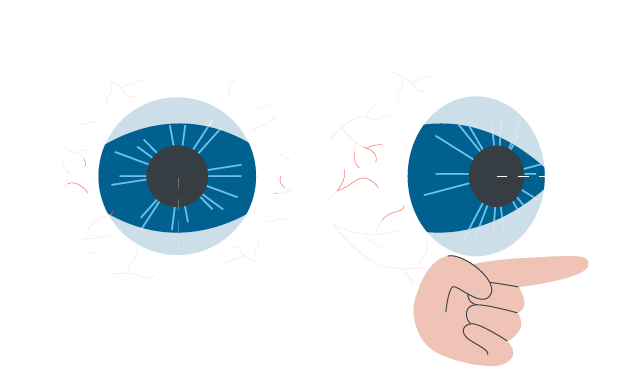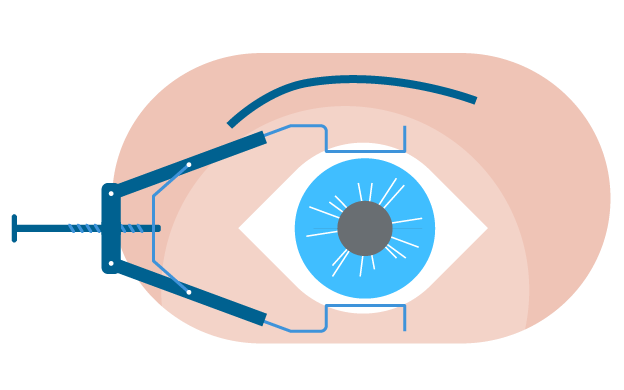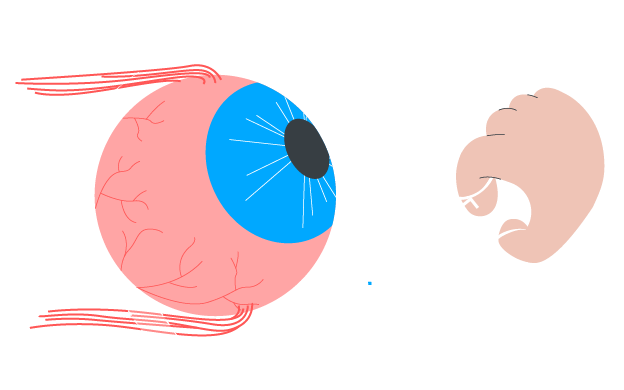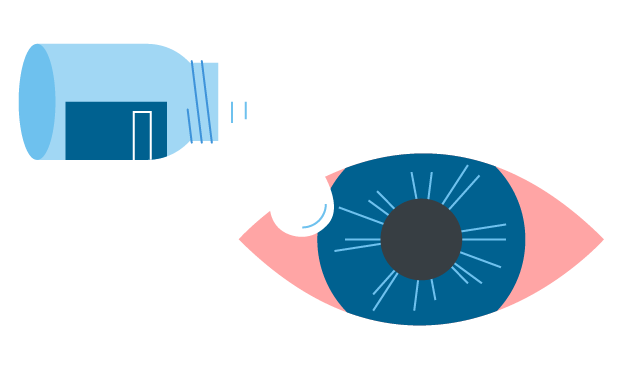I've had Minimal Invasive Strabismus Surgery (MISS) in 2019. [1]

Although the eye muscle surgery was done incredibly well by the surgeon - which happened to be the inventor of MISS – the end results were quite disappointing.
On the other hand, I have a handful of friends that have undergone the eye operation and raved about it's results years later.
So... is surgery of your eye muscles worth it?
In this article you'll learn:
- What strabismus surgery is - and if it makes sense for you (depends on factors such as current alignment of the eyes).
- How surgery is performed and what to expect (general anesthesia, cut into eye muscles, hospital visit, eye correction)
- How long the recovery process typically is (level of pain, what happens in the first few days after surgery, common symptoms)
- How to quicken the recovery process (tactics to reduce the redness, medication)
Let's dive right in:
1. Strabismus: The Basics

Before eye muscle surgery is considered, we first have to clear the air about the underlying issue it's aiming to cure: Eye misalignment.
1.1 What is the main cause of eye misalignment?
A person with strabismus has misaligned eyes. Meaning: Both eyes are not pointing in the same direction (either due to muscular issues, or brain issues - or both in summation). [2]
1.2 Is strabismus the same as lazy eye?
While people often use strabismus and lazy eye simultaneously, they are not the same. Strabismus is the actual phenomena of the eyes not being aligned. Meaning: One eye looks in one direction, the other eye in the other.
Lazy eye is 'amblyopia', meaning: The loss of vision in one eye (often caused by the misalignment of the eyes, so due to 'strabismus').
Approximately 2% of the global population is suffering from eye misalignment. [3]
1.3 How do you get rid of strabismus?
The only way to fix eye misalignment - is where it originated. We have to train – or force via operative means - both our eyes in the same direction.
- Surgery works that way: The surgeon forces your eye muscles to pull in the same direction via a surgical incision.
- And so do all vision therapy methods: The Brock String, VR Training, various Amblyopia Games – they train your eye muscles to look in the same direction.
- Prism glasses (almost) do work that way: The glasses change the light rays direction, making sure the light rays hit the right part of the retina. [4]
Squint (strabismus) can be treated or strongly improved without a surgical procedure. Yet surgery is the most common procedure recommended for strabismus.
However even though it's high recommended by doctors, only 1 out of 20 people that suffer from strabismus opt for surgery. But why? [5]
2. Introducing Strabismus Surgery

Despite only a small percentage of people opting for surgery, it's still very wide-spread: 1,2 million strabismus surgeries are done per year in the United States, which makes it a routine procedure. [6]
2.1 Is strabismus surgery serious?
While the procedure is 'serious'...
... meaning: A surgeon cuts into your face. The complications usually are not. [7]
2.2 Is strabismus eye surgery safe?
Yes, the eyes are severely bloodshot afterwards. Scarring is an issue. So is under-and overcorrection, with a decent high re-operation rate of at least 10% (over the first year only). [8]
But major hiccups are very unlikely. Such as 'lost muscle', or death due to general anesthesia (1 in 100,000, which is very low). This is a great article outlining all major and minor complications: https://www.tandfonline.com/doi/abs/10.3109/08820538.2014.959190?journalCode=isio20
Surgery should be given enough thought. A good risk-benefit analysis should be made. But overall, it's a very safe procedure.
2.3 Is strabismus surgery worth it in adults?
Generally speaking, yes. The risks are generally lower in adults than with infants or children. [9] So it's merely a question of how high the benefits are.
And the benefits might indeed be less.
Not only do adults have less time ahead than children (given, well, their age) - they also have a bigger inertia due to their previous visual behavioural patterns: If you're used to seeing crossed for a long period of time, it is harder for the brain to re-learn to see properly.
Which could explain the decreased success rate of strabismus surgery in adults. [10]
2.4 Does strabismus surgery improve double vision?
The benefits clearly outweigh the risks in extreme strabismus (high prism diopters) or double vision. Surgery is significantly more effective for treatment of double vision than alternative treatment options (at-home-training, vision therapy) probably ever will be.
3. What Happens During Strabismus Surgery

First and foremost, strabismus surgery is an outpatient procedure. This means, that you do not need to stay at a hospital overnight. The surgeon will do the procedure, and afterwards, you can go home.The surgery is performed quickly. My procedure took about 30 minutes, as I had only one eye to operate on (yours may take a bit longer, up to 1.5 hours in total). [11]
3.1 What do they do in strabismus surgery?
After putting you under anesthesia, the surgeon will cut into a specific eye muscles (the muscles they cut into depends on which type of strabismus you have)
And then re-attach the eye muscle at a more favorable position. So your eyes are aligned.
3.2 What is an adjustable suture?
During the surgery the doctor will re-attach the muscle at a more favorable position. Instead of tying a permanent knot, the doctor will do a bow-knot or slip-knot (temporary knot) on the muscle which can be changed. [12]
This adjustable suture is a wonderful idea, as the initial eyes might not be aligned 100% correct. As a result, the sutures can be adjusted so the eyes are then, well, aligned 100% correct.
Surgery should be given enough thought. A good risk-benefit analysis should be made. But overall, it's a very safe procedure.
3.3 Will you be awake during surgery?
Although most children are treated with general anesthetic, adults generally have sedation options with local anesthetic.
I have personally chosen the general anesthetic one. Meaning: Once the surgery starts you fall asleep, and about 30 minutes later, you wake up.
3.4 Is eye muscle surgery painful?
During the surgery you do not feel a thing. You're asleep. Or if you're chosen a local anesthetic: The specific nerve cells are incapable of transmitting the information. So again, you do not feel a thing.
After the eye muscle surgery, you might typically feel some pain though (espeically during eye movement):
4. What happens after strabismus surgery in

You've done the surgery, so... what now?
4.1 What are the side effects of the procedure?
Overall, if you're a normal surgery patient, you'll experience very little discomfort.
In the days following the procedure your eye will appear red, yes. It pains a bit during eye movement, yes. But there is only blood on the surface of the eye. Meaning: Your eye will not start bleeding (like the villain in Casino Royale... "Weeping blood comes merely from a derangement of the tear duct, my dear General. Nothing sinister.").
4.2 How long does it take to heal after strabismus surgery?
Within a few days, patients should be totally free of symptoms. You can resume your normal activities within a week or two. On average, the recovery is quick. It will not take several weeks to heal.
The doctors will prescribe some medication (typically eye drops) to reduce pain and speed up the recovery.
4.3 Are eyes straight immediately after strabismus surgery?
In short: Yes. Normal eye alignment should occur immediately in the hospital room after surgical intervention.
Now, the alignment is sometimes obscured by swellings or bruising. Give it 4-8 weeks of recovery (or, well, listen to your doctor) to judge the final eye alignment.
Lastly, do you feel not yet ready for surgery?

Surgery is generally an effective, and very safe procedure. However, some of us are prohibited due to the high price tag, residual risk and time investment (recovery, and meeting with doctors and surgeons).
Again, that's why generally only 1 out of 20 people with strabismus opt for an invasive procedure. Luckily, there are other treatment strategies. But we believe, none so good as our own Lazyeyefix Ai Software.
The goal of our company Lazyeyefix.com is to offer an effective starter treatment to everyone suffering from strabismus. It's inexpensive, easy to use - and takes almost no time. We use artificial intelligence to do so.
Our software is not a replacement for surgery by any means, but it can help the 19 out of 20 people that do not yet feel ready. Are you interested in that? Click the link below to instantly download our software for free.
For Windows: https://dashboard.lazyeyefix.com/download/w/
For MacOS: https://dashboard.lazyeyefix.com/download/m/
References:
[1] Minimally Invasive Surgery: https://www.ncbi.nlm.nih.gov/pmc/articles/PMC4330290/
[2] Strabismus by Cleveland Clinic: https://my.clevelandclinic.org/health/diseases/15065-strabismus-crossed-eyes
[3] Global and regional prevalence of strabismus: a comprehensive systematic review and meta-analysis: https://pubmed.ncbi.nlm.nih.gov/31012389/
[4] What Is Prism Correction In Eye Glasses? https://www.aao.org/eye-health/glasses-contacts/what-is-prism-correction-in-eyeglasses
[5] Strabismus, Strabismus Surgery, and Reoperation Rate in the United States: Analysis from the IRIS Registry: https://pubmed.ncbi.nlm.nih.gov/29779683/
[6] Surgery is a routine procedure: https://www.aao.org/eye-health/tips-prevention/lazy-eye-surgery-facts
[7] Complications of Strabismus Surgery: Incidence and Risk Factors: https://www.tandfonline.com/doi/abs/10.3109/08820538.2014.959190?journalCode=isio20
[8] Strabismus, Strabismus Surgery, and Reoperation Rate in the United States: Analysis from the IRIS Registry: https://pubmed.ncbi.nlm.nih.gov/29779683/
[9] Conjunctival cysts as a complication after strabismus surgery: https://pubmed.ncbi.nlm.nih.gov/20795604/
[10] Strabismus surgery - Fact Sheet: https://visioneyeinstitute.com.au/eyematters/strabismus-surgery-2/
[11] Outcome of strabismus surgery in congenital esotropia: https://pubmed.ncbi.nlm.nih.gov/1622945/
[12] Adjustable Sutures in Strabismus Surgery: https://aapos.org/glossary/adjustable-sutures-in-strabismus-surgery
![The Truth About Strabismus Surgery for Misaligned Eyes, Crossed Eyes or Wall Eyes [2025 Update]](/images/1_the-20truth-20about-20strabismus-20surgery.png)





